window FIAT DUCATO BASE CAMPER 2015 Owner handbook (in English)
[x] Cancel search | Manufacturer: FIAT, Model Year: 2015, Model line: DUCATO BASE CAMPER, Model: FIAT DUCATO BASE CAMPER 2015Pages: 367, PDF Size: 19.73 MB
Page 11 of 367
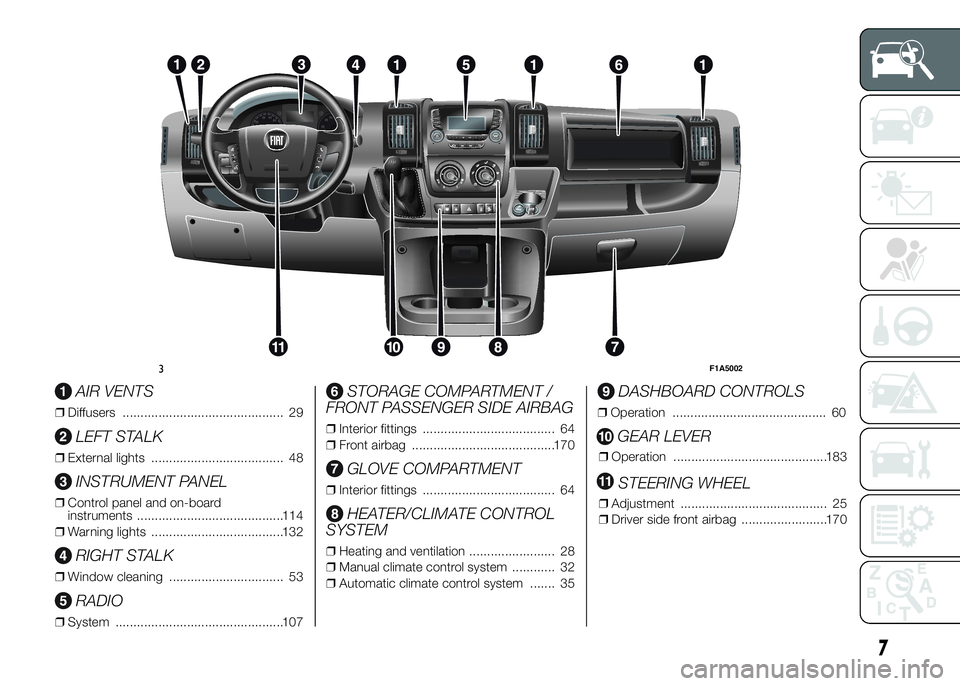
.
AIR VENTS
❒Diffusers ............................................. 29
LEFT STALK
❒External lights ..................................... 48
INSTRUMENT PANEL
❒Control panel and on-board
instruments .........................................114
❒Warning lights .....................................132
RIGHT STALK
❒Window cleaning ................................ 53
RADIO
❒System ...............................................107
STORAGE COMPARTMENT /
FRONT PASSENGER SIDE AIRBAG
❒Interior fittings ..................................... 64
❒Front airbag ........................................170
GLOVE COMPARTMENT
❒Interior fittings ..................................... 64
HEATER/CLIMATE CONTROL
SYSTEM
❒Heating and ventilation ........................ 28
❒Manual climate control system ............ 32
❒Automatic climate control system ....... 35
DASHBOARD CONTROLS
❒Operation ........................................... 60
GEAR LEVER
❒Operation ...........................................183
STEERING WHEEL
❒Adjustment ......................................... 25
❒Driver side front airbag ........................170
RADIO
MEDIA
PHONEINFO
A-B-C
MENU
123 4 56
3F1A5002
7
Page 13 of 367
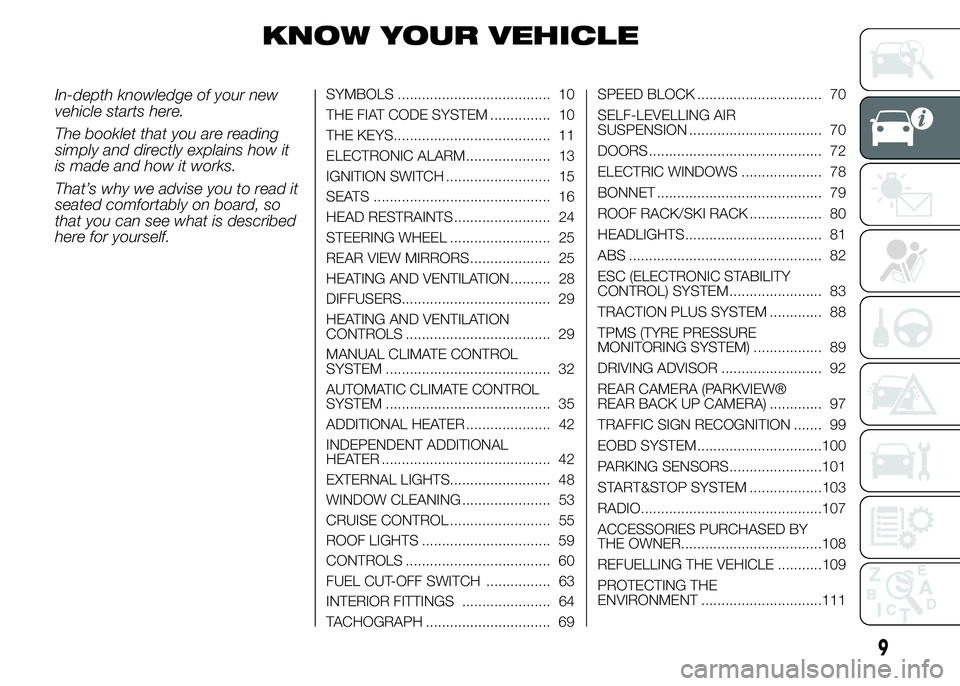
KNOW YOUR VEHICLE
In-depth knowledge of your new
vehicle starts here.
The booklet that you are reading
simply and directly explains how it
is made and how it works.
That’s why we advise you to read it
seated comfortably on board, so
that you can see what is described
here for yourself.SYMBOLS ...................................... 10
THE FIAT CODE SYSTEM ............... 10
THE KEYS....................................... 11
ELECTRONIC ALARM..................... 13
IGNITION SWITCH .......................... 15
SEATS ............................................ 16
HEAD RESTRAINTS ........................ 24
STEERING WHEEL ......................... 25
REAR VIEW MIRRORS .................... 25
HEATING AND VENTILATION.......... 28
DIFFUSERS..................................... 29
HEATING AND VENTILATION
CONTROLS .................................... 29
MANUAL CLIMATE CONTROL
SYSTEM ......................................... 32
AUTOMATIC CLIMATE CONTROL
SYSTEM ......................................... 35
ADDITIONAL HEATER ..................... 42
INDEPENDENT ADDITIONAL
HEATER .......................................... 42
EXTERNAL LIGHTS......................... 48
WINDOW CLEANING ...................... 53
CRUISE CONTROL ......................... 55
ROOF LIGHTS ................................ 59
CONTROLS .................................... 60
FUEL CUT-OFF SWITCH ................ 63
INTERIOR FITTINGS ...................... 64
TACHOGRAPH ............................... 69SPEED BLOCK ............................... 70
SELF-LEVELLING AIR
SUSPENSION ................................. 70
DOORS ........................................... 72
ELECTRIC WINDOWS .................... 78
BONNET ......................................... 79
ROOF RACK/SKI RACK .................. 80
HEADLIGHTS.................................. 81
ABS ................................................ 82
ESC (ELECTRONIC STABILITY
CONTROL) SYSTEM ....................... 83
TRACTION PLUS SYSTEM ............. 88
TPMS (TYRE PRESSURE
MONITORING SYSTEM) ................. 89
DRIVING ADVISOR ......................... 92
REAR CAMERA (PARKVIEW®
REAR BACK UP CAMERA) ............. 97
TRAFFIC SIGN RECOGNITION ....... 99
EOBD SYSTEM...............................100
PARKING SENSORS.......................101
START&STOP SYSTEM ..................103
RADIO.............................................107
ACCESSORIES PURCHASED BY
THE OWNER...................................108
REFUELLING THE VEHICLE ...........109
PROTECTING THE
ENVIRONMENT ..............................111
9
Page 31 of 367
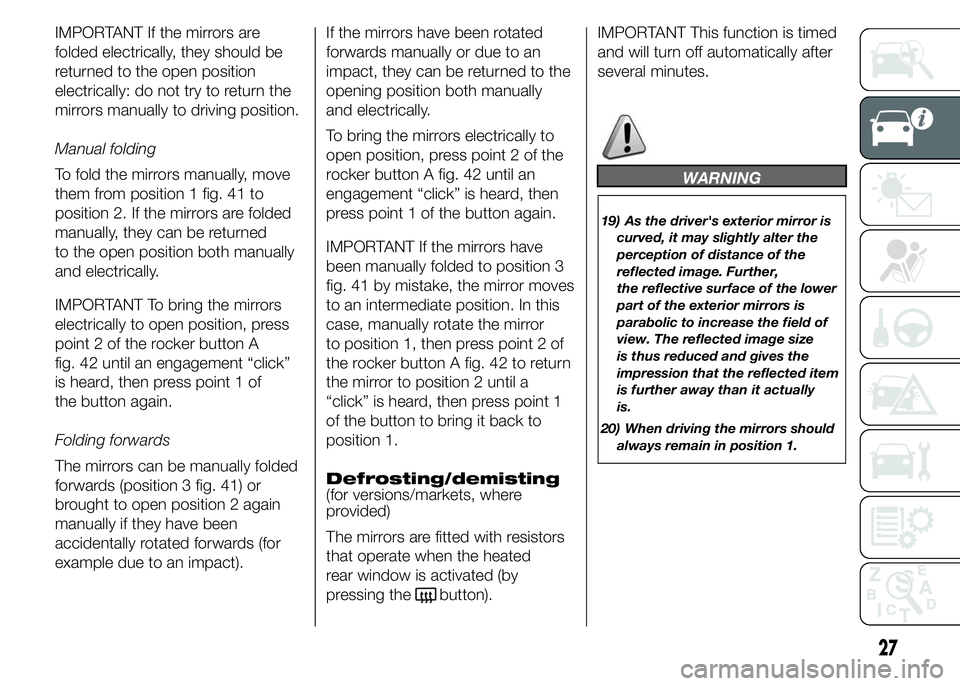
IMPORTANT If the mirrors are
folded electrically, they should be
returned to the open position
electrically: do not try to return the
mirrors manually to driving position.
Manual folding
To fold the mirrors manually, move
them from position 1 fig. 41 to
position 2. If the mirrors are folded
manually, they can be returned
to the open position both manually
and electrically.
IMPORTANT To bring the mirrors
electrically to open position, press
point 2 of the rocker button A
fig. 42 until an engagement “click”
is heard, then press point 1 of
the button again.
Folding forwards
The mirrors can be manually folded
forwards (position 3 fig. 41) or
brought to open position 2 again
manually if they have been
accidentally rotated forwards (for
example due to an impact).If the mirrors have been rotated
forwards manually or due to an
impact, they can be returned to the
opening position both manually
and electrically.
To bring the mirrors electrically to
open position, press point 2 of the
rocker button A fig. 42 until an
engagement “click” is heard, then
press point 1 of the button again.
IMPORTANT If the mirrors have
been manually folded to position 3
fig. 41 by mistake, the mirror moves
to an intermediate position. In this
case, manually rotate the mirror
to position 1, then press point 2 of
the rocker button A fig. 42 to return
the mirror to position 2 until a
“click” is heard, then press point 1
of the button to bring it back to
position 1.
Defrosting/demisting
(for versions/markets, where
provided)
The mirrors are fitted with resistors
that operate when the heated
rear window is activated (by
pressing the
button).IMPORTANT This function is timed
and will turn off automatically after
several minutes.
WARNING
19) As the driver's exterior mirror is
curved, it may slightly alter the
perception of distance of the
reflected image. Further,
the reflective surface of the lower
part of the exterior mirrors is
parabolic to increase the field of
view. The reflected image size
is thus reduced and gives the
impression that the reflected item
is further away than it actually
is.
20) When driving the mirrors should
always remain in position 1.
27
Page 33 of 367
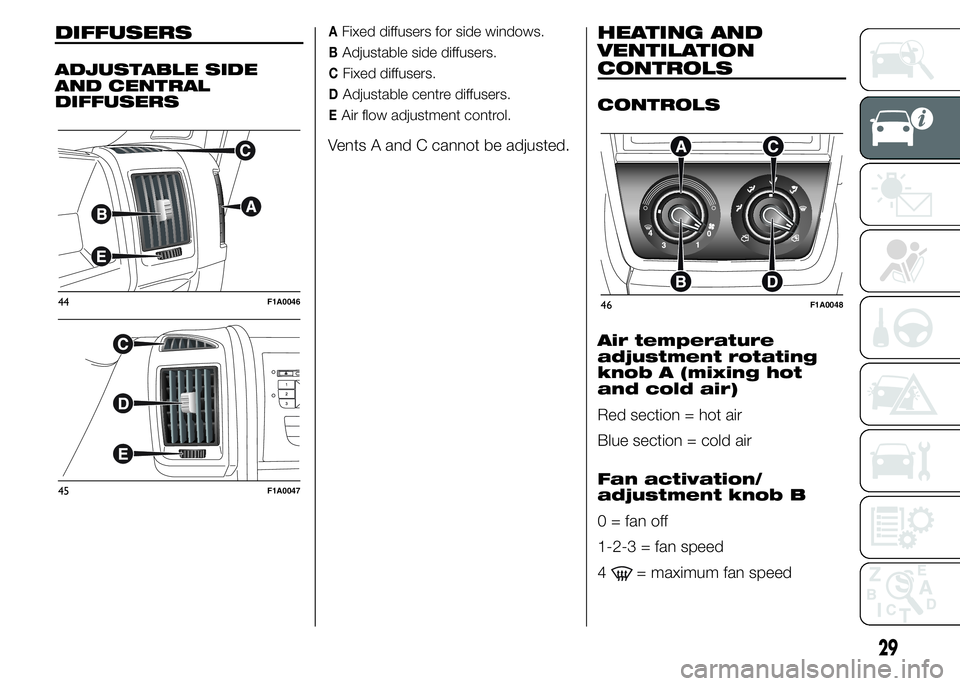
DIFFUSERS
ADJUSTABLE SIDE
AND CENTRAL
DIFFUSERS
AFixed diffusers for side windows.
BAdjustable side diffusers.
CFixed diffusers.
DAdjustable centre diffusers.
EAir flow adjustment control.
Vents A and C cannot be adjusted.
HEATING AND
VENTILATION
CONTROLS
CONTROLS
Air temperature
adjustment rotating
knob A (mixing hot
and cold air)
Red section = hot air
Blue section = cold air
Fan activation/
adjustment knob B
0 = fan off
1-2-3 = fan speed
4
= maximum fan speed
44F1A0046
45F1A0047
46F1A0048
29
Page 34 of 367
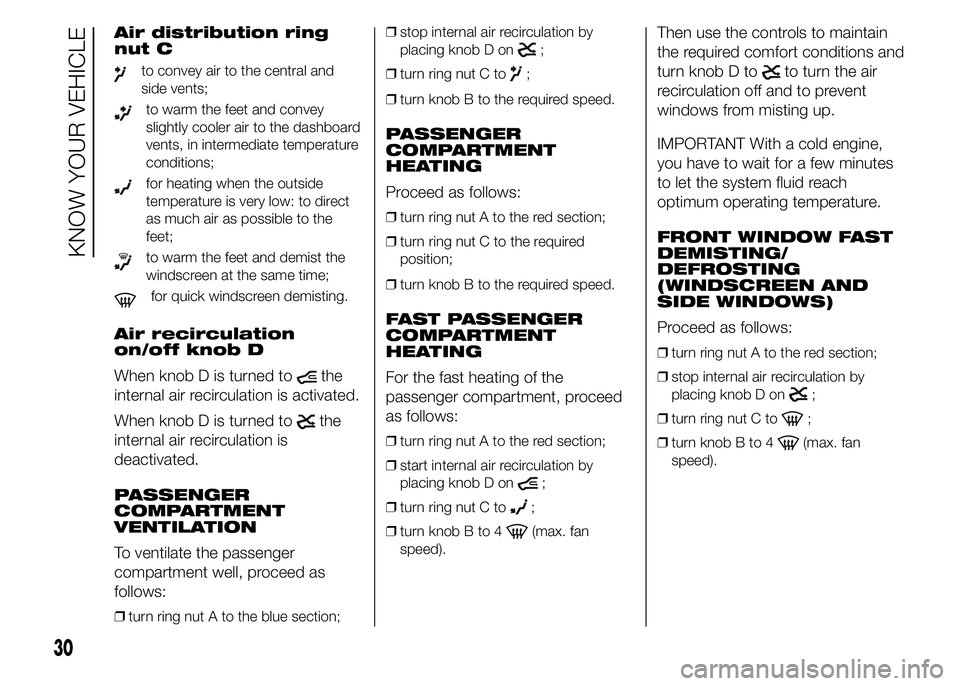
Air distribution ring
nut C
to convey air to the central and
side vents;
to warm the feet and convey
slightly cooler air to the dashboard
vents, in intermediate temperature
conditions;
for heating when the outside
temperature is very low: to direct
as much air as possible to the
feet;
to warm the feet and demist the
windscreen at the same time;
for quick windscreen demisting.
Air recirculation
on/off knob D
When knob D is turned to
the
internal air recirculation is activated.
When knob D is turned to
the
internal air recirculation is
deactivated.
PASSENGER
COMPARTMENT
VENTILATION
To ventilate the passenger
compartment well, proceed as
follows:
❒turn ring nut A to the blue section;❒stop internal air recirculation by
placing knob D on
;
❒turn ring nut C to
;
❒turn knob B to the required speed.
PASSENGER
COMPARTMENT
HEATING
Proceed as follows:
❒turn ring nut A to the red section;
❒turn ring nut C to the required
position;
❒turn knob B to the required speed.
FAST PASSENGER
COMPARTMENT
HEATING
For the fast heating of the
passenger compartment, proceed
as follows:
❒turn ring nut A to the red section;
❒start internal air recirculation by
placing knob D on
;
❒turn ring nut C to
;
❒turn knob B to 4
(max. fan
speed).
Then use the controls to maintain
the required comfort conditions and
turn knob D to
to turn the air
recirculation off and to prevent
windows from misting up.
IMPORTANT With a cold engine,
you have to wait for a few minutes
to let the system fluid reach
optimum operating temperature.
FRONT WINDOW FAST
DEMISTING/
DEFROSTING
(WINDSCREEN AND
SIDE WINDOWS)
Proceed as follows:
❒turn ring nut A to the red section;
❒stop internal air recirculation by
placing knob D on
;
❒turn ring nut C to
;
❒turn knob B to 4
(max. fan
speed).
30
KNOW YOUR VEHICLE
Page 35 of 367
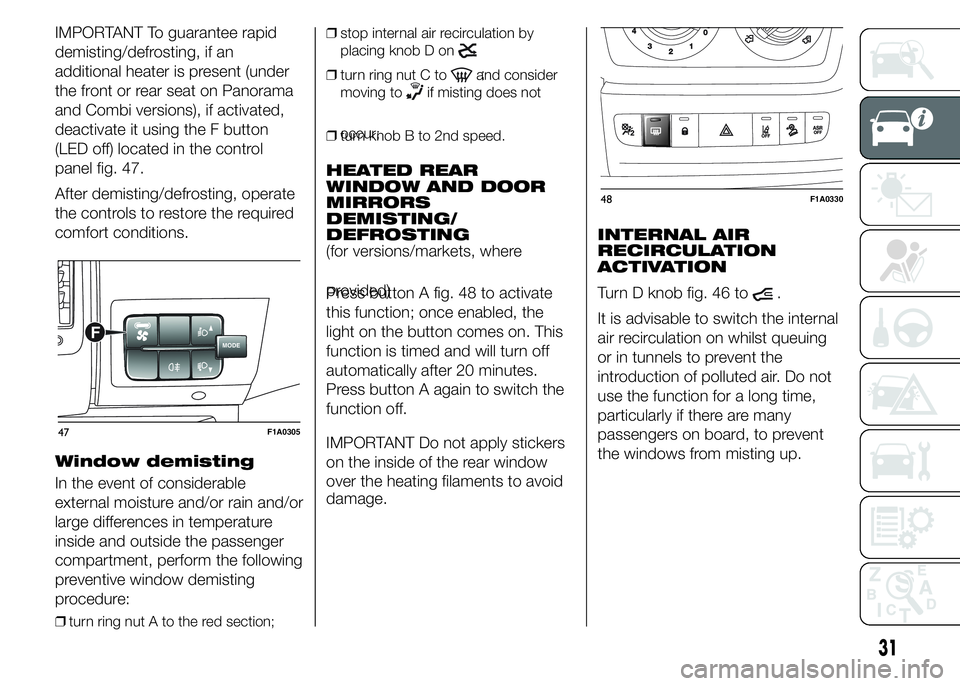
IMPORTANT To guarantee rapid
demisting/defrosting, if an
additional heater is present (under
the front or rear seat on Panorama
and Combi versions), if activated,
deactivate it using the F button
(LED off) located in the control
panel fig. 47.
After demisting/defrosting, operate
the controls to restore the required
comfort conditions.
Window demisting
In the event of considerable
external moisture and/or rain and/or
large differences in temperature
inside and outside the passenger
compartment, perform the following
preventive window demisting
procedure:
❒turn ring nut A to the red section;❒stop internal air recirculation by
placing knob D on
;
❒turn ring nut C toand consider
moving to
if misting does not
occur;
❒turn knob B to 2nd speed.
HEATED REAR
WINDOW AND DOOR
MIRRORS
DEMISTING/
DEFROSTING
(for versions/markets, where
provided)
Press button A fig. 48 to activate
this function; once enabled, the
light on the button comes on. This
function is timed and will turn off
automatically after 20 minutes.
Press button A again to switch the
function off.
IMPORTANT Do not apply stickers
on the inside of the rear window
over the heating filaments to avoid
damage.INTERNAL AIR
RECIRCULATION
ACTIVATION
Turn D knob fig. 46 to
.
It is advisable to switch the internal
air recirculation on whilst queuing
or in tunnels to prevent the
introduction of polluted air. Do not
use the function for a long time,
particularly if there are many
passengers on board, to prevent
the windows from misting up.
MODEF
47F1A0305
48F1A0330
31
Page 36 of 367
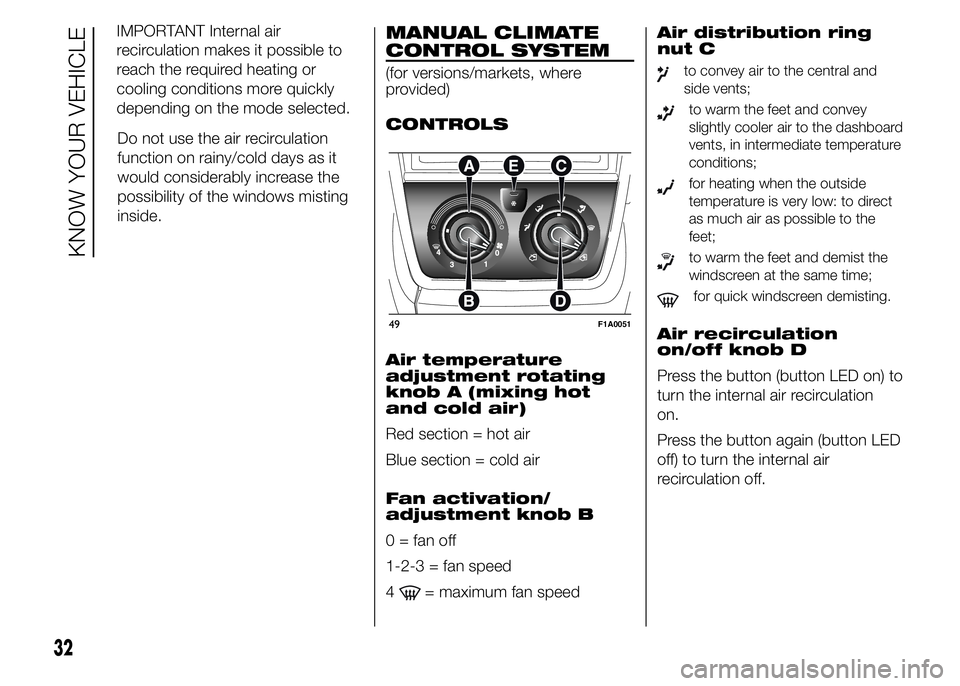
Do not use the air recirculation
function on rainy/cold days as it
would considerably increase the
possibility of the windows misting
inside.
MANUAL CLIMATE
CONTROL SYSTEM
(for versions/markets, where
provided)
CONTROLS
Air temperature
adjustment rotating
knob A (mixing hot
and cold air)
Red section = hot air
Blue section = cold air
Fan activation/
adjustment knob B
0 = fan off
1-2-3 = fan speed
4
= maximum fan speedAir distribution ring
nut C
to convey air to the central and
side vents;
to warm the feet and convey
slightly cooler air to the dashboard
vents, in intermediate temperature
conditions;
for heating when the outside
temperature is very low: to direct
as much air as possible to the
feet;
to warm the feet and demist the
windscreen at the same time;
for quick windscreen demisting.
Air recirculation
on/off knob D
Press the button (button LED on) to
turn the internal air recirculation
on.
Press the button again (button LED
off) to turn the internal air
recirculation off.49F1A0051
32
KNOW YOUR VEHICLE
IMPORTANT Internal air
recirculation makes it possible to
reach the required heating or
cooling conditions more quickly
depending on the mode selected.
Page 37 of 367
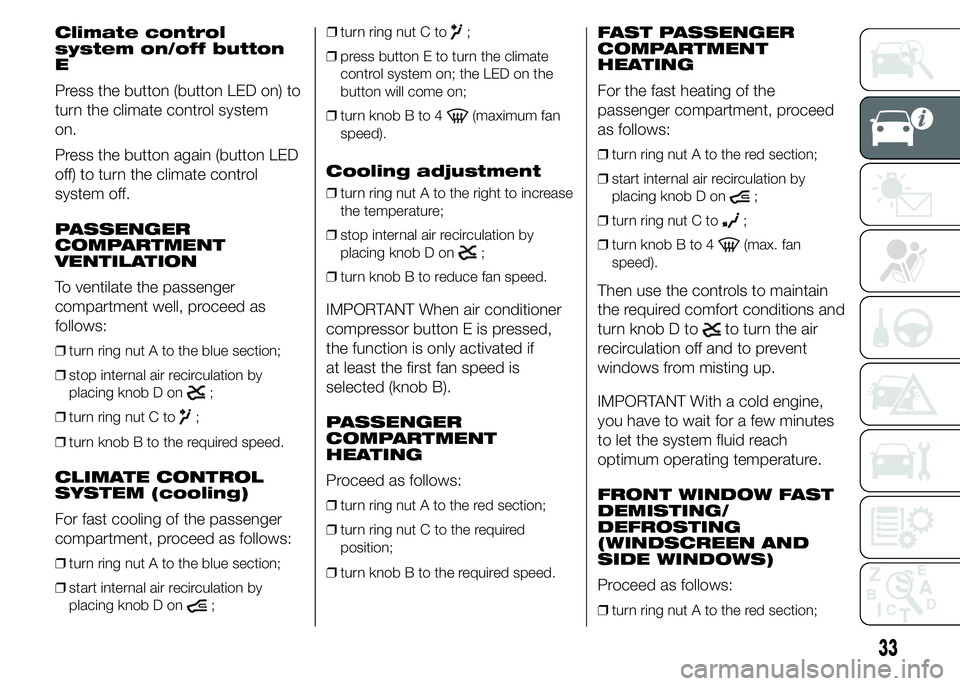
Climate control
system on/off button
E
Press the button (button LED on) to
turn the climate control system
on.
Press the button again (button LED
off) to turn the climate control
system off.
PASSENGER
COMPARTMENT
VENTILATION
To ventilate the passenger
compartment well, proceed as
follows:
❒turn ring nut A to the blue section;
❒stop internal air recirculation by
placing knob D on
;
❒turn ring nut C to
;
❒turn knob B to the required speed.
CLIMATE CONTROL
SYSTEM (cooling)
For fast cooling of the passenger
compartment, proceed as follows:
❒turn ring nut A to the blue section;
❒start internal air recirculation by
placing knob D on
;❒turn ring nut C to
;
❒press button E to turn the climate
control system on; the LED on the
button will come on;
❒turn knob B to 4
(maximum fan
speed).
Cooling adjustment
❒turn ring nut A to the right to increase
the temperature;
❒stop internal air recirculation by
placing knob D on
;
❒turn knob B to reduce fan speed.
IMPORTANT When air conditioner
compressor button E is pressed,
the function is only activated if
at least the first fan speed is
selected (knob B).
PASSENGER
COMPARTMENT
HEATING
Proceed as follows:
❒turn ring nut A to the red section;
❒turn ring nut C to the required
position;
❒turn knob B to the required speed.
FAST PASSENGER
COMPARTMENT
HEATING
For the fast heating of the
passenger compartment, proceed
as follows:
❒turn ring nut A to the red section;
❒start internal air recirculation by
placing knob D on
;
❒turn ring nut C to
;
❒turn knob B to 4
(max. fan
speed).
Then use the controls to maintain
the required comfort conditions and
turn knob D to
to turn the air
recirculation off and to prevent
windows from misting up.
IMPORTANT With a cold engine,
you have to wait for a few minutes
to let the system fluid reach
optimum operating temperature.
FRONT WINDOW FAST
DEMISTING/
DEFROSTING
(WINDSCREEN AND
SIDE WINDOWS)
Proceed as follows:
❒turn ring nut A to the red section;
33
Page 38 of 367
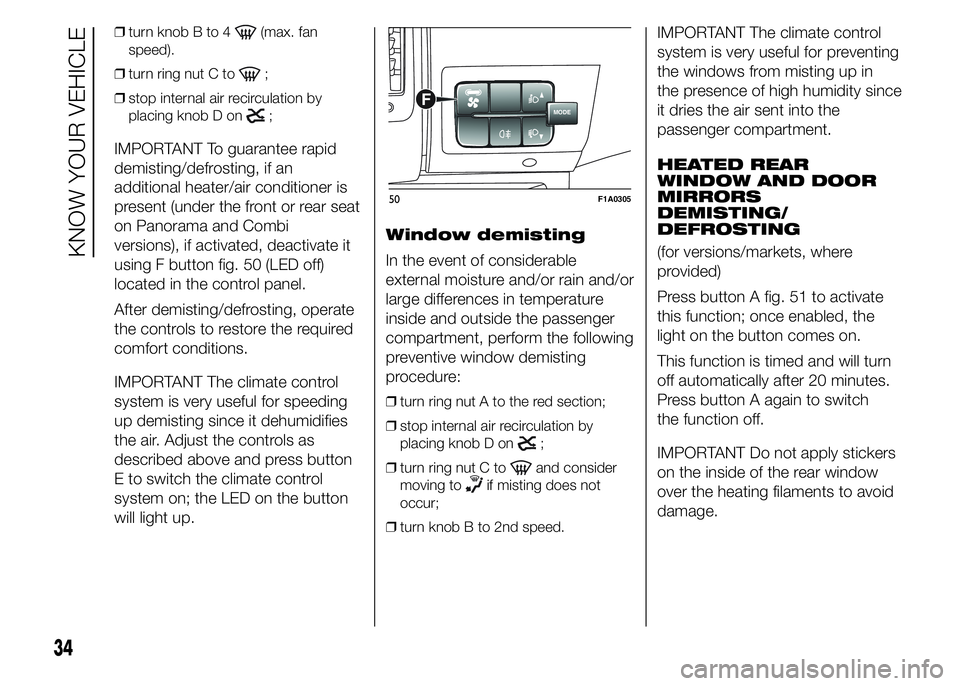
❒turn knob B to 4(max. fan
speed).
❒turn ring nut C to
;
❒stop internal air recirculation by
placing knob D on
;
IMPORTANT To guarantee rapid
demisting/defrosting, if an
additional heater/air conditioner is
present (under the front or rear seat
on Panorama and Combi
versions), if activated, deactivate it
using F button fig. 50 (LED off)
located in the control panel.
After demisting/defrosting, operate
the controls to restore the required
comfort conditions.
IMPORTANT The climate control
system is very useful for speeding
up demisting since it dehumidifies
the air. Adjust the controls as
described above and press button
E to switch the climate control
system on; the LED on the button
will light up.Window demisting
In the event of considerable
external moisture and/or rain and/or
large differences in temperature
inside and outside the passenger
compartment, perform the following
preventive window demisting
procedure:
❒turn ring nut A to the red section;
❒stop internal air recirculation by
placing knob D on
;
❒turn ring nut C to
and consider
moving to
if misting does not
occur;
❒turn knob B to 2nd speed.
IMPORTANT The climate control
system is very useful for preventing
the windows from misting up in
the presence of high humidity since
it dries the air sent into the
passenger compartment.
HEATED REAR
WINDOW AND DOOR
MIRRORS
DEMISTING/
DEFROSTING
(for versions/markets, where
provided)
Press button A fig. 51 to activate
this function; once enabled, the
light on the button comes on.
This function is timed and will turn
off automatically after 20 minutes.
Press button A again to switch
the function off.
IMPORTANT Do not apply stickers
on the inside of the rear window
over the heating filaments to avoid
damage.
MODEF
50F1A0305
34
KNOW YOUR VEHICLE
Page 39 of 367
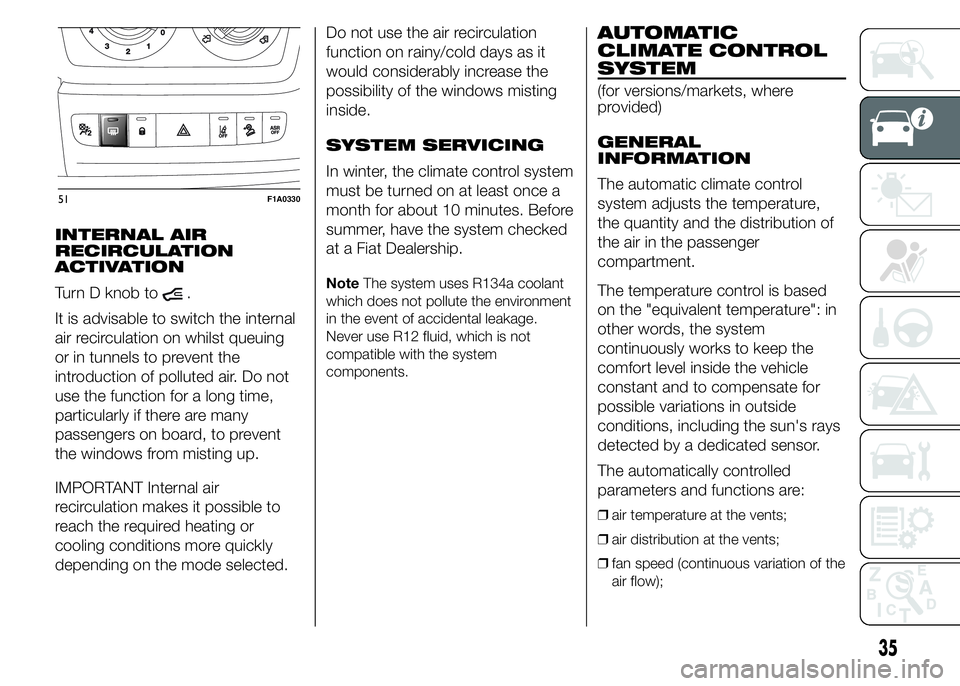
INTERNAL AIR
RECIRCULATION
ACTIVATION
Turn D knob to
.
It is advisable to switch the internal
air recirculation on whilst queuing
or in tunnels to prevent the
introduction of polluted air. Do not
use the function for a long time,
particularly if there are many
passengers on board, to prevent
the windows from misting up.
IMPORTANT Internal air
recirculation makes it possible to
reach the required heating or
cooling conditions more quickly
depending on the mode selected.Do not use the air recirculation
function on rainy/cold days as it
would considerably increase the
possibility of the windows misting
inside.
SYSTEM SERVICING
In winter, the climate control system
must be turned on at least once a
month for about 10 minutes. Before
summer, have the system checked
at a Fiat Dealership.NoteThe system uses R134a coolant
which does not pollute the environment
in the event of accidental leakage.
Never use R12 fluid, which is not
compatible with the system
components.
AUTOMATIC
CLIMATE CONTROL
SYSTEM
(for versions/markets, where
provided)
GENERAL
INFORMATION
The automatic climate control
system adjusts the temperature,
the quantity and the distribution of
the air in the passenger
compartment.
The temperature control is based
on the "equivalent temperature": in
other words, the system
continuously works to keep the
comfort level inside the vehicle
constant and to compensate for
possible variations in outside
conditions, including the sun's rays
detected by a dedicated sensor.
The automatically controlled
parameters and functions are:
❒air temperature at the vents;
❒air distribution at the vents;
❒fan speed (continuous variation of the
air flow);
51F1A0330
35